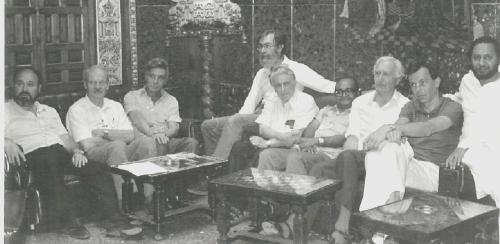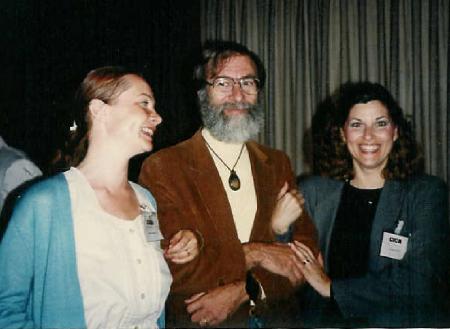Stories
The Seville Statement Newsletter
Mayor DiLieto and the Peace Commission
Plans for
a general human theory
Facing the internal culture of war
Student Conferences at Wesleyan
Shell mobiles
* * *
The Seville Statement on Violence
Once the Statement on Violence was written and signed at Seville, the hardest work began - to publicize it and make it known around the world. This was some of the most productive work I have ever done.
At the core of the work was the Seville Statement Newsletter. From the beginning I established a pattern for it: a 2-page letter followed by photocopies of original documents such as letters sent to the newsletter or copies of newspaper and magazine articles. For the most part I let the documents speak for themselves. A full set of the newsletters, over 30 in all, is available in my archives at Wesleyan University, including literally hundreds of individual initiatives, publications and endorsements; there is space here to touch on only a few of the highlights.
The mailing list grew from less than 100 to over 1000 over the years, as I sent out three or four newsletters a year from 1986 until I obtained a formal staff position at UNESCO in the fall of 1993. To support the mailings, many people and organizations on the mailing list sent contributions. Also, I received a small grant from the Harry Frank Guggenheim Foundation and later from the President's Fund at Wesleyan and then from UNESCO.
The thrust of our work, as reflected in the newsletters from 1986 and 1987, was to obtain organizational endorsements from scientific and public organizations, as well as to have the Statement published in as many languages and media outlets as possible. As Seville signatory Federico Mayor wrote to us in a letter (quoted in the SSOV newsletter of October 5, 1986): "The Seville Statement on Violence is acquiring support and dissemination because it is an excellent and timely text... Our snowball is growing fast... If all the snowballs starting their way would have such strength, all the world would be covered with snow. I hope that we will succeed to cover it with peace." Mayor also said that he was asking the Spanish UNESCO Commission to present the statement to UNESCO for its endorsement.
An initial breakthrough was reported in the newsletter of February 3, 1987, by Doug Fry who obtained a resolution from the annual meetings of the American Anthropological Association in support of the Seville Statement. on that basis, a number of us who were psychologists began a process to obtain similar endorsement by the American Psychological Association (APA). The organization Psychologists for Social Responsibility, of which I was a Steering Committee member, was especially helpful. This was accomplished in the summer of 1987 as described in the newsletter of October 1987. Unfortunately, as I describe in my article on the Seville Statement in the Journal of Peace Research, (see http://www.culture-of-peace.info/ssov/title-page.html) despite our best efforts the mass media, including Science magazine refused to cover the event at the APA. However, we were able to use the APA endorsement later to convince the popular magazine Psychology Today to bring out a special issue on the Seville Statement in June 1988.
The next major breakthrough came in the fall of 1987, as reported in the Newsletter Vol 2, No 3 of February 1988. Seville signatory Federico Mayor was elected the Director-General of UNESCO, and he included the message of the Seville Statement in his opening address on accepting the nomination! Mayor's election opened up many opportunities at UNESCO, beginning with presentation of the Seville Statement at the Yamoussoukro peace conference in 1989, my preparation of a brochure on the Seville Statement in 1990-1991 (on line at http://www.culture-of-peace.info/brochure/titlepage.html), and later with my preparation of flyers and a poster in 1992, at which time I proposed to Mayor the Culture of Peace Programme.
By November 1988 (Newsletter Vol 3, No 2), I was able to report 24 organizational endorsements and 44 publications in 21 countries and 13 languages. This continued to grow over the years, as reported in the newsletters, to the point that Newsletter Vol 10, No 1 which I put on the Internet in 2002, listed approximately 60 organizational endorsements and 150 publications (see http://www.culture-of-peace.info/SSOVnews211/page1.html). Approximately 5,000 pages of correspondence on which the newsletter was based are filed chronologically in two containers at my apartment. A full set of newsletters is deposited at my Wesleyan archives, and was put on my personal Internet site in 2010.
The Seville Statement Newsletter is no longer regularly issued and there is no longer an active network of communication around it, although Riitta Wahlstrom sent out a few issues in 1994, and I put a few issues on line in 2002 (see http://www.culture-of-peace.info/ssov-intro.html). But the need is as great as ever for such a network and newsletter. As we showed in the paper that I delivered to Seville, people are less likely to work for peace if they believe in the myth that war is biologically determined, and probably half of all young people still believe in this myth.
As I wrote in the 1989 article on the Seville Statement in the Journal of Peace Research:

Some of the Seville signatories, from left to right: Martin Ramirez, Paul Scott, Santiago Genoves, myself, Ben Ginsburg, Samir Ghosh, Robert Hinde, Joe Groebel and Ashis Nandy. The women had not yet arrived when this photo was taken, including Bonnie Frank Carter, Riitta Wahlstrom, and Diana Mendoza (see below). Click on photo to enlarge.

At Seville with signatories Riitta Wahlstrom and Bonnie Frank Carter
The myth that war is part of human nature does not appear to be so much an inherent component of 'common sense' so much as it is the end result of a campaign of psychological propaganda that has been promulgated in the mass media in order to justify political policies of militarism ... the task of providing the opinion of science which challenges this myth is not simply a problem of providing knowledge to people that are uninformed. Instead, we are faced with a more difficult task of engaging in a kind of psychological warfare with certain sectors of the media and related institutions who are engaged in producing the very ignorance that must be challenged. If anything, the difficulty we face may become greater as time goes on, for the more the political and economic justifications for war are discredited, the more we may expect these sectors to fall back on the psychological justifications for war. (http://www.culture-of-peace.info/ssov/chapter5-8.html)
 |
Stages
1986-1992
Fall of Soviet Empire
1992-1997
UNESCO Culture of Peace Programme